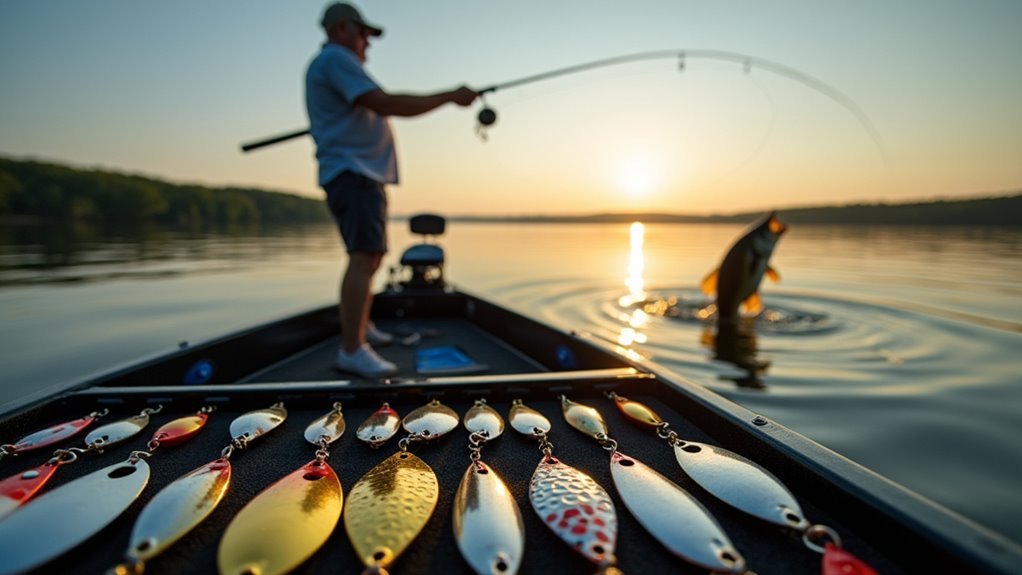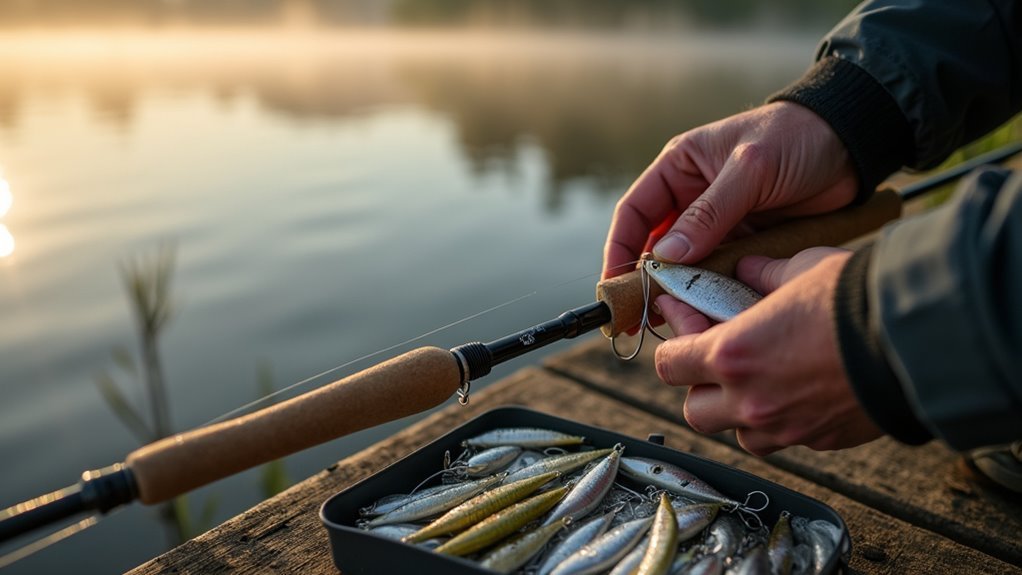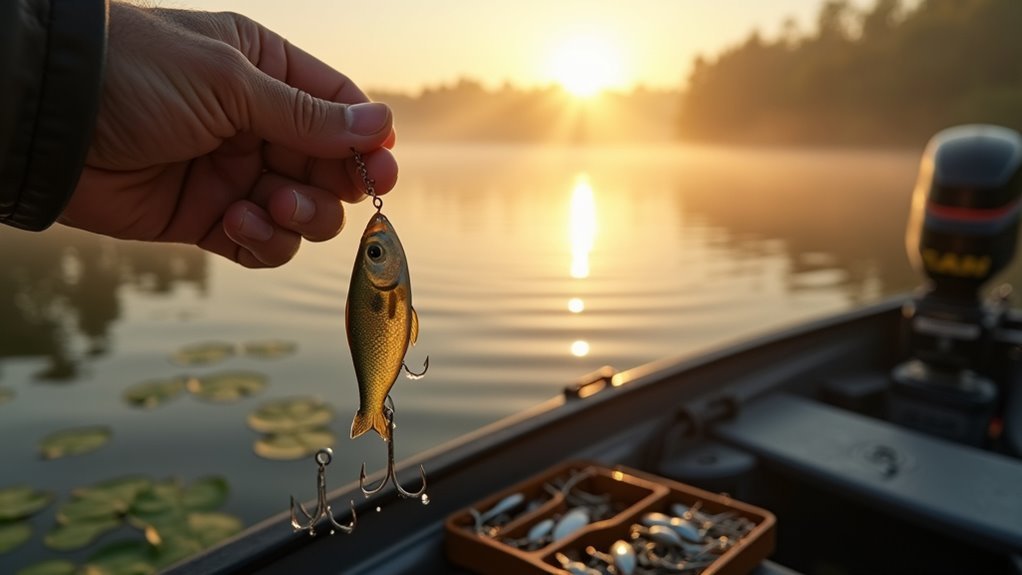We’ve caught countless bass using spoons by matching the right type to the situation. Jigging spoons shine in deep water, while weedless models excel in summer vegetation. Use an 8-10lb test line on a quality spinning setup, and master vertical jigging, swimming retrieves, and trolling techniques. Remember that bright days usually outfish cloudy ones, and each season demands different approaches. Our tackle box always holds these fluttering, flashing bass magnets for good reason.
The Essential Anatomy of Bass Fishing Spoons

When you’re standing at the water’s edge ready to catch some bass, understanding what makes a spoon tick can be the difference between going home with fish stories or just plain stories.
We’ve found that spoons come in four main varieties for bass fishing: casting, jigging, weedless, and trolling spoons. Each has its purpose – jigging spoons shine in deep water with their fluttering fall, while weedless models excel in vegetation. The magic happens with the flash and wobble that mimics injured baitfish. Remember, heavier spoons sink faster, and a single hook setup often beats treble hooks for fewer snags.
Selecting the Right Spoon Type for Your Bass Target

Now that you’re familiar with spoon anatomy, it’s time to match the right spoon to your bass fishing mission. We’ve learned through countless early mornings on the water that each spoon type has its sweet spot.
Casting spoons work for panfish but aren’t ideal for bass. Instead, grab jigging spoons for deep-water action—they’re deadly when dropped vertically where big bass lurk. For those weedy summer spots where monsters hide, weedless spoons are your best friend. And when covering distance matters, Krocodile trolling spoons with their signature “S” wiggle will get the job done.
Gear Setup: Optimizing Your Rod and Line for Spoon Success

The perfect spoon setup begins with the right rod and reel combination, creating a foundation for bass fishing success. We’ve found a quality spinning combo gives you the smoothest retrieval and natural fall that bass can’t resist.
Stick with 8-10lb test line—anything heavier just isn’t necessary and can hamper your presentation. We’ve lost count of the monster bass we’ve landed on lighter line!
Braided line works wonders in heavy vegetation, while mono gives simplicity for beginners. Add a swivel to prevent those frustrating line twists we’ve all battled during active retrievals.
Mastering the Four Core Spoon Techniques for Trophy Bass

Successful anglers know that mastering different spoon techniques can make the difference between coming home empty-handed or with a trophy bass. We’ve learned through countless dawn patrols that versatility is key when working spoons.
Here are the core techniques every bass angler should perfect:
- Vertical Jigging – Let that spoon flutter down on slack line where deep bass lurk
- Swimming Retrieve – Pump your rod tip to create darting action that triggers reaction strikes
- Trolling Method – Use Krocodile spoons for that perfect wobble in open water
Each technique shines in different conditions. We’ve filled livewells using these methods when others went home skunked!
Seasonal Strategies: When and Where to Deploy Your Spoon Arsenal

While bass behaviors shift dramatically throughout the year, understanding these seasonal patterns will dramatically boost your spoon fishing success. In spring, focus on tributaries and creek channels where oxygen-rich water attracts feeding bass. Early summer mornings are prime for slop spoons in shallow vegetation when the sun’s reflection triggers strikes. During hot mid-summer days, switch to jigging spoons in deeper water where bass retreat to cooler temperatures. Come fall, trolling with Krocodile spoons becomes deadly effective as bass chase baitfish schools. We’ve found that bright, sunny days consistently outperform overcast conditions for all spoon techniques, regardless of season.
Troubleshooting Common Spoon Fishing Challenges
Even experienced anglers face frustrating moments with spoon fishing, but we’ve learned that most problems have simple solutions. After countless days on the water, we’ve identified these common challenges:
Fishing spoons may seem simple, but knowing how to overcome their challenges separates casual anglers from consistent catchers.
- Line Twist – Add a quality swivel between your line and lure to prevent this frustrating issue.
- Too Many Snags – Switch from treble hooks to single hooks when fishing heavy cover, and consider weedless spoons in vegetation.
- No Bites Despite Flash – Adjust your retrieval speed – sometimes slower is better in cold water, while faster works in summer when bass are more active.
Frequently Asked Questions
Are Metal Spoons Effective in Muddy or Stained Water Conditions?
Yes, we find metal spoons work well in muddy water. Their flash and vibration help bass locate them when visibility is poor. We’d recommend brighter colors for maximum effectiveness.
How Do Spoons Compare to Crankbaits for Targeting Suspended Bass?
While spoons excel at vertical presentations for suspended bass, crankbaits offer better horizontal coverage. We’d choose spoons for deeper, concentrated fish and crankbaits when bass are scattered across varying depths.
Can Spoons Be Effectively Paired With Soft Plastic Trailers?
We don’t typically pair spoons with soft plastic trailers. Unlike jigs or bladed baits, spoons rely on their metallic flash and wobbling action, which soft plastics might interfere with.
How Does Water Temperature Affect Spoon Selection and Presentation?
We’ve found that 80% of successful bass catches occur within their preferred temperature range. In cold water, we use jigging spoons retrieved slowly, while in warmer waters, faster-moving weedless spoons mimic active prey better.
What Are the Best Spoon Modifications for Pressured Bass?
We recommend using smaller, lighter spoons with single hooks for pressured bass. We’ve found that adding feathers or mylar, and dulling flashy finishes with spray paint creates subtler presentations they’ll strike.
Conclusion
Just as we were losing hope on Lake Champlain last summer, we switched to a silver spoon and landed three trophy bass in thirty minutes! We’ve shared our hard-earned techniques, and now it’s your turn. With the right spoon, proper gear, and our seasonal strategies, you’ll be reeling in bass when others go home empty-handed. Get out there and make your own spoon fishing memories!